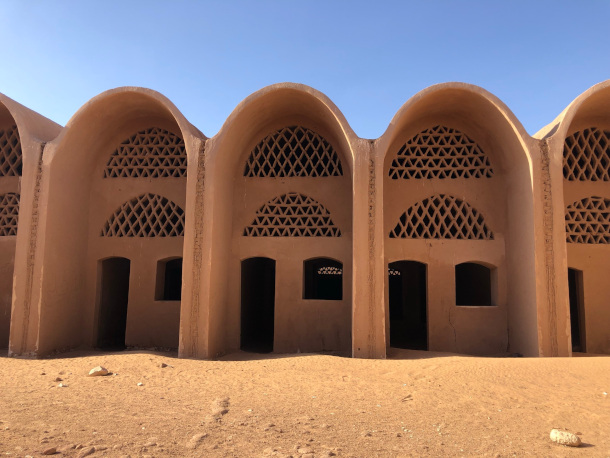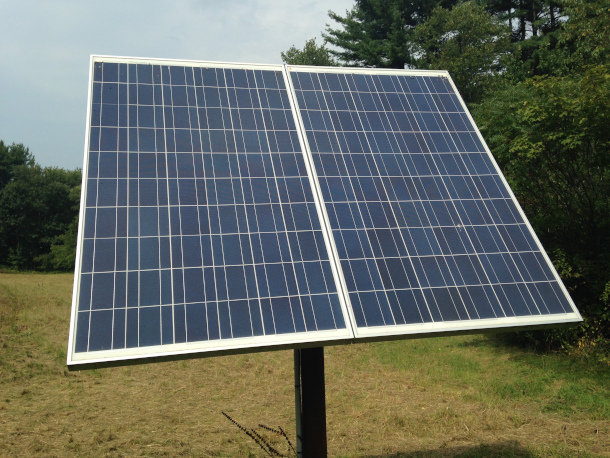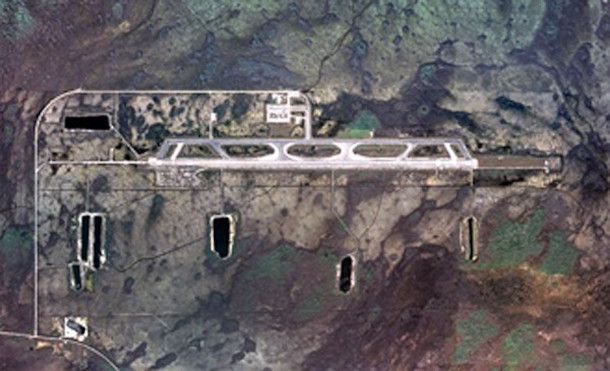Beyond the Headlines
Air Date: Week of January 12, 2024

Hassan Fathy’s work uses ancient architectural principles to help buildings in hot climates stay cool in sustainable ways. (Photo: Viktor Lazić, Wikimedia Commons, CC BY-SA 4.0)
This week, Living on Earth Contributor Peter Dykstra joins Host Paloma Beltran with a couple of stories about thoughtful dwelling design. In sweltering Egypt, buildings that incorporate centuries-old techniques help naturally keep inhabitants cool. And in Florida, residents in a new development designed with plentiful rooftop solar and energy efficiency pay nothing for electricity. In history they look back to when the Nixon administration stepped in to block a massive jetport that could have impacted the delicate Everglades ecosystem.
Transcript
BELTRAN: It’s time now for a look beyond the headlines, and on the line from Atlanta, Georgia is Living on Earth Contributor Peter Dykstra. Hey, Peter, what do you have for us today?
DYKSTRA: Hi Paloma. We're going to start with a situation where innovation is based on centuries and centuries of knowledge. This really, really interesting story out of the Washington Post, about an architect named Hassan Fathy. This is right after World War Two. Fathy in his native Egypt, started designing homes and communities, mostly for poor people. And those walls and designs and courtyards, in traditional Middle Eastern architecture, helped cool buildings in very, very typically hot climate, talking about over 100 degrees Fahrenheit during the day, thick earthen walls, courtyards that help channel winds to cool things off. And some really forward thinking ideas that are based on ancient ideas, not only in Egypt, but in Turkey as well.
BELTRAN: It sounds like we can learn a thing or two from Hassan Fathy about building for community while dealing with rising temperatures.
DYKSTRA: That's right.
BELTRAN: Well, what else do you have for us, Peter?

The residents of Hunters Point, Florida use solar energy primarily to power their homes and produce enough to sell back to the electrical company. (Photo: MarkBuckawicki, Wikimedia Commons, Public Domain)
DYKSTRA: We'll go to Hunters Point, Florida. It's a new community part of Sarasota on the Gulf Coast. It's the world's first LEED certified zero energy, residential development, 86 homes that produce their own electricity. And not only that, but they're able to sell some of it back to the utility. Not only is there no electric bill for much of the time at Hunters Point, but you actually can make money back. The community is dealing with solar and other means of energy conservation in a way that should be a model everywhere.
BELTRAN: And of course, Florida is prone to hurricanes, which come with a lot of blackouts.
DYKSTRA: A lot of blackouts, that's something else that Hunters Point, is able to overcome because in generating their own electricity, and being capable of being off the grid, they don't have to worry about those huge blackouts that come after huge hurricanes. And not only that, wait, there's more like they say on the TV commercials. It's in a very vulnerable spot in Florida on the Gulf Coast for hurricanes. But the community has built its roads raised up by several feet to help deal with storm surge, or sea level rise. They also have their own barrier islands, so Hunters Point will have much less damage in a hurricane than neighboring communities.

Although Nixon blocked the full construction of the Everglades Jetport, its remains can still be seen. (Photo: National Park Service, NPS.gov)
BELTRAN: Wow, energy efficient and storm proof. You gotta wonder, are they living in the future? Now I hear you have another story from Florida for the history books.
DYKSTRA: What appears to be a good idea from 1970, specifically January 14th, 1970, when several Florida State agencies came together with the White House and President Nixon to block completion of the partially built, Big Cypress Jetport was going to be a Mega Jet poured in the middle of the Everglades to serve both Florida's East Coast and the rapidly growing West Coast cities like Fort Myers. But there was worry that the building of the sprawling airport would do irreparable harm to Florida's Everglades. What's left of the Big Cypress Jetport can still be seen on Google Earth, some overrun runways and other vestiges of a project that was a really bad environmental idea.
BELTRAN: Well, thanks, Peter. Peter Dykstra is a contributor for Living on Earth. We'll talk to you again real soon.
DYKSTRA: All right, Paloma, thanks a lot, talk to you soon.
BELTRAN: And there's more on the stories on the Living on Earth website. That's loe.org.
Links
Read the original Washington Post story about Fathy’s work.
Living on Earth wants to hear from you!
Living on Earth
62 Calef Highway, Suite 212
Lee, NH 03861
Telephone: 617-287-4121
E-mail: comments@loe.org
Newsletter [Click here]
Donate to Living on Earth!
Living on Earth is an independent media program and relies entirely on contributions from listeners and institutions supporting public service. Please donate now to preserve an independent environmental voice.
NewsletterLiving on Earth offers a weekly delivery of the show's rundown to your mailbox. Sign up for our newsletter today!
 Sailors For The Sea: Be the change you want to sea.
Sailors For The Sea: Be the change you want to sea.
 The Grantham Foundation for the Protection of the Environment: Committed to protecting and improving the health of the global environment.
The Grantham Foundation for the Protection of the Environment: Committed to protecting and improving the health of the global environment.
 Contribute to Living on Earth and receive, as our gift to you, an archival print of one of Mark Seth Lender's extraordinary wildlife photographs. Follow the link to see Mark's current collection of photographs.
Contribute to Living on Earth and receive, as our gift to you, an archival print of one of Mark Seth Lender's extraordinary wildlife photographs. Follow the link to see Mark's current collection of photographs.
 Buy a signed copy of Mark Seth Lender's book Smeagull the Seagull & support Living on Earth
Buy a signed copy of Mark Seth Lender's book Smeagull the Seagull & support Living on Earth

